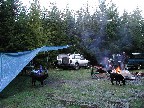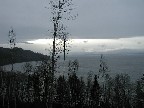Search and Rescue Report |
4/1/2006 to 4/2/2006 |
| The NARG trip this month was to an area along the banks of the Columbia River in Washington. A few of us headed out a day early to collect a near by creek that produces several crab species from the Lincoln Creek Formation (Eocene). The primary crab I'm looking for is the Ranina ranina. They are fairly common in this area if you know what concretions to look for but the preservation, for the most part, is very poor.
We got an early start Saturday morning and made it to the creek by 10am. I was a little concerned that the water level would be high after a night of heavy rain but it was running clear and at an acceptable level. I decided to forgo my waders and planned on just getting wet. I did wear my felt bottom wading boots, which are a must on the slippery, slimy rocks. The creek water was pretty dang cold and I wondered if I made the right decisions about the waders. From past experience I knew my feet would get cold enough that I wouldn't feel them so I continued up stream. All the December rains we had made a huge difference and many of the landmarks along the creek I've become familiar with had moved or were gone completely. I'm sure the beavers had a rough season as their dam was blown out and I didn't see any evidence of recent activity. It wasn't long before I found my first keeper of the day. It was a fairly large concretion and I could see evidence of crab legs on either end. Based on the color of the concretion I'm fairly certain it's a Pulalius vulgaris. I won't pop this one but will start preparing it from the front to expose the claws to help in determining its orientation in the nodule. Soon I had enough concretions to drop my first cache that will be loaded up on my trip out. One concretion in the cache was a 15 pounder that contained a very nicely preserved Pulalius. It was a tiny crab compared to the size of the ball but I just had to pack it out. After an hour and a half of collecting I had dropped another cache and my pack was half full. Up to this point I found several Ranina crabs but nothing outstanding, one gastropod with barnacles, 1 shark vertebra, and 30 unopened concretions. Bill and Andy passed me on the way out. Bill didn't seem to be fairing as well and they wanted to head upstream further. Half way out I had to take a break. The pack was getting very heavy and I had one more cache to pick up. As I sat there I noticed several small concretions, no bigger than 1 inch in diameter, poking out of large chunks of matrix that had recently slid. Normally these go uncollected but one was split and had an imprint of a Pulalius carapace and legs. I popped a few out and split one, which included a juvenile Pulalius with a carapace under a 1/2 inch in diameter. After rounding up about 20 of these small concretions it was time to continue my journey out. I could hardly get the pack off the ground after loaded up the last cache of concretions and I had concerns that my $5 pack from the thrift store would fail. I managed to get the pack on and started out. Even with the concretions in the pack pressing into my spine and numb arms from the blood supply being pinched off from the shoulder straps I still managed to bend down on several occasions to check out concretions I missed on the way up. If I had a job that required this much physical activity I'd be looking for a career change. The things we do for fossils. Eventually I got to the truck and loaded up. Jerry and I took off for the campsite eager to get setup before the forecasted rains showed up. We brought a tent along but decided to just setup a tarp. We had a huge 20' x 30' tarp that should accommodate us all. The setup takes longer than a tent but it gives us such a large living area. Bill and Andrew arrived with the rain. The tarp city shed the heavy rain as designed and luckily there wasn't much wind. It doesn't take much wind, especially with a tarp as large as we setup, to cause havoc. The rains eventually subsided, sky's cleared, and the campfire was ablaze again. We turned in early eager for another day of collecting with other NARG members. Breakfast was great and after a few cups of coffee we were on the road again. It was a dog day with Jerry and his 3 dogs and Bill, Skip and Tim bringing their pooches along as well. I sure wish I could bring along my Beagles but I'd be spending most of my time trying to find where they ran off too. A short hike and we were on the beach in search of concretions that have weathered out of the Lincoln Creek and Astoria Formations. The plan for a few of us was to hike up the beach a few miles to an old slide area to look for crabs. What I really wanted to find on this trip was a glass sponge and a spider crab. Unfortunately someone else found those but I did end up with a whale and shark vertebra, and numerous mud shrimp (Callianasis) claws but the find of the day for me was a Portunid crab of some type. If you like Teredo wood this is the place to collect it. One piece is enough for my collection but I was a bit envious of a chunk that Andy found. After several hours of busting concretions and not coming up with much we decided to call it a day. |
| ©2004 NARG - North America Research Group |







